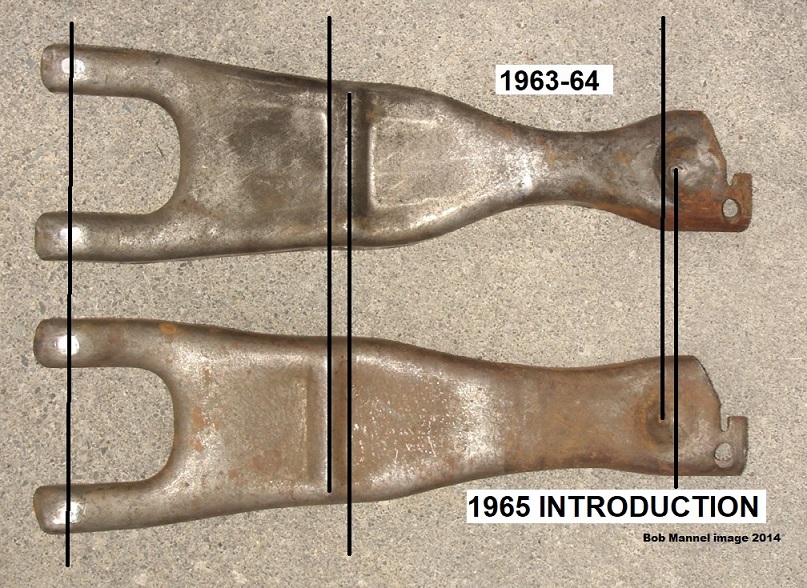CSX2001-CSX2589 Cobras and potential clutch system parts compatibility issues.
If you are working on an original CSX2001-CSX2589 Cobra and the car has problems with getting a clutch system back together or it has operational problems, you might want to be aware of some technical topics. All manual transmission American market CSX2 prefix chassis Cobras, which was all but sixteen each late cars (one prototype and fifteen production cars) and one prototype car used with a FE engine, were equipped with some variant of some model year five bolt bell housing design 260 or 289 c.i.d. engine. The vast majority of these cars came with 1963 or 1964 model year 289 High Performance engines.
In no particular order:
1) Engine cylinder block assemblies of the five bolt design bell housing type must use the clutch release lever made for 260/289 five bolt design original engines. If somebody installs the design of lever introduced for 1965 model year 289 six bolt engines, the clutch system will not work properly as the functional lengths of features are different. I have been contacted a few times over several years where this was a problem when the installer was not aware that not all levers were the same functionally.

2) Pilot tips of factory original equipment Borg-Warner T-10 transmissions for 260/289 engines and any Ford FE engine are different with the big block model gears having shorter pilot tips. If a input from a FE engine transmission is used with a 260/289 engine, a special pilot bearing is required to capture the tip of the input shaft.
3) Some Cobras, street and race, used a gear set with an input adopted from a General Motors version of T-10 transmission. The spline count is the same as the Ford part but the diameter is different. A clutch disc assembly designed for a Ford 260/289 engine of any version alone will not fit!
K (high nickel) set = installed into aluminum cased Cobra transmissions, street and race, introduced sometime in the CSX22xx range it is believed, example CSX2246 had a K set originally, our black car CSX2310 was fitted with a K set. (The K gear ratios originated in some high performance GM cars.) Listed as the alternate gear set in the February 1964 Cobra reconfirmation of registration for roadsters and coupes with the Fédération Internationale de l'Automobile (F.I.A.) race sanctioning organization. Application Notes: 1) The Ford 289 High Performance clutch disc will not work with the K set input. A disc that will work with the GM input is required because the outer diameters of the Ford and GM splines are different. I used a McLeod® part number 260240 disc in CSX2310 and it has served very well for decades. 2) The pilot tip of the GM design input shaft is smaller in diameter than the O.E. Ford T-10 transmissions and that requires the use of a suitable pilot bearing in the rear end of the engine crankshaft.
4) Not a parts compatibility issue but something to consider, a COBRA lettered cast steel safety bell housing (a.k.a. scatter shield). After seeing pictures of what happens when there is a flywheel or clutch failure in a Cobra using a stock die cast aluminum bell housing, I have zero interest in sitting in a Cobra with the engine running without a safety bell housing in use. The COBRA lettered models, there were several slight variations over time, are wonderful THE FIRST TIME they have to contain a problem. I have seen the aftermath of a flywheel / clutch failure in a friend’s race car with a tachometer tell tale indicating the engine was running over 9,000 rpm when the failure occurred. The driver was not injured. The car chassis was not damaged. The engine and transmission were both seriously damaged, but all the major projectiles were contained. The COBRA housing did not fracture anywhere but it was deformed seriously and deemed not useable anymore.
Safety Housing Side Bar: The manufacturer also sold the same design with “WEDGE” (one of their trade names) or “TIGER” lettering. Other companies made their own versions of safety housings in cast steel for five bolt bell housing engines that work fine in original Cobras.
How about COB/COX60 prefix leaf spring car chassis? Based on records available, most of the cars used five bolt bell housing design engines. Some late cars used six bolt bell housing design engines. It would be important stock parts wise to use the correct lever for the type of cylinder block design used.